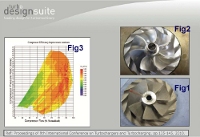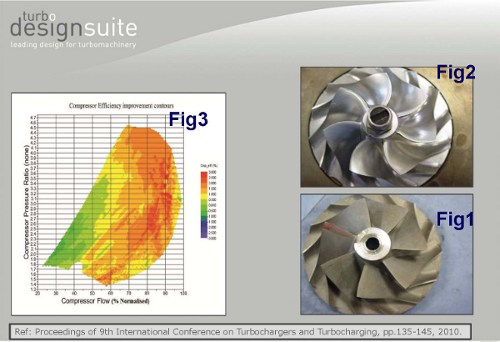 |
| February 19, 2013 | Volume 09 Issue 07 |
Designfax weekly eMagazine
Archives
Partners
Manufacturing Center
Product Spotlight
Modern Applications News
Metalworking Ideas For
Today's Job Shops
Tooling and Production
Strategies for large
metalworking plants
Engineer's Toolbox:
How aerodynamic design methodology can help meet commercial challenges in the off-highway industry

By Mehrdad Zangeneh, Ph.D.,
Founder and Managing Director, TURBOdesign Technology, Inc.
London, U.K.
The off-highway industry is facing many of the same challenges as the commercial and automotive industries: a) drive to reduce fuel consumption, b) drive to reduce production costs, c) drive to reduce design time, and d) shortage of skilled designers. Each component on a vehicle plays a critical role in addressing the challenges listed. In this article, we will be focusing on turbomachinery components and how software can be used to meet the challenges.
There are basically two approaches to the aerodynamic design of turbomachinery: direct design and inverse design.

In the direct method, the blade geometry is specified, and the resulting flow field calculated via computational fluid dynamics (CFD). The designer evaluates the analysis and determines whether the design meets requirements: pressure rise, flow, and efficiency. If the design does not meet conditions, the designer modifies the geometry to improve the performance.
This process requires extensive experience to know what impact geometry modifications have on performance and may require a large number of iterations to meet the basic design requirements of flow and pressure rise. Then, the designer has to spend additional time trying to improve the efficiency.
Experienced designers can achieve good performance. However, they tend to stay within their comfort zones, and, as a result, this can limit the design space, making it difficult to meet today's challenges for better efficiency or broader operating range. In many turbocharger or torque converter applications, it is becoming more difficult to achieve better performance improvement based on conventional or direct design approach.
In the inverse design method, the desired flow field (via blade loading) is specified along with the total work required, and the geometry that produces that flow field is generated. Specifying the blade loading gives direct control over the 3D pressure and velocity distributions, which allow for direct control of the 3D flow field. Thus, there is an intuitive connection between the design input and the resulting performance. This allows the designer to explore a large part of the design space, and hence arrive at breakthrough designs.
For example, the compressor shown in Fig. 1 (see below) was designed by conventional design methods by a leading heavy-duty diesel engine turbocharger manufacturer. Despite continuous attempts to improve the performance of this compressor, no improvements had been achieved in more than 10 years.

By using the inverse design approach, the impeller shown in Fig. 2 was designed. Test data showed a 2.5- to 3-point improvement in efficiency over most of the map (see Fig. 3). This improvement in performance is particularly significant given the failure of all attempts by direct design to improve the efficiency.
The resulting geometry has 3D blades and had to be manufactured by a point-milling process. This, in fact, does not pose a huge problem, even in relatively high-volume applications such as turbochargers. Many turbocharger manufacturers are using the point-milling process, because this provides better structural reliability as compared to the casting process.
Another interesting feature of the new impeller design obtained by the inverse design process was the fact that, despite its 3D shape, the stresses in the impeller were comparable to the original design, and its vibration response was better than the baseline impeller.
Application of inverse design in other turbomachinery applications related to off-highway, such as torque converters, has also resulted in significant improvement in efficiency. The inverse design approach can provide a significant improvement in performance as well as reduction in design and development times. The other advantage is that new designers do not have to have years of experience to use the inverse design approach. A fundamental understanding of the fluid flow allows them to start designing higher performing turbomachinery in a shorter amount of time.
Want more information? Click below to learn more about the TURBOdesign Suite of software products.
Published February 2013
Rate this article
View our terms of use and privacy policy
